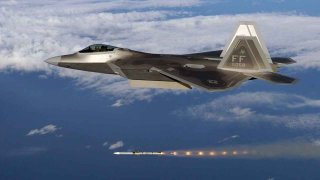Why We Will Never See Another F-22 Raptor
The Soviet Union’s fall and the subsequent end of the Cold War forced a reexamination of spending priorities. No longer were defense projects simply handed a blank check. The F-22's production was eventually halted.
The Cold War competition with the Soviet Union inspired the United States to invest heavily in defense. Partially realism, partially paranoia, the Cold War atmosphere resulted in impressive military developments including, but not limited to, intercontinental ballistic missiles, stealth aircraft, fourth-generation tanks, nuclear-powered aircraft carriers, and the Apollo moon missions. The realm of aerospace, in particular, saw bounding progress, as the Soviets and Americans spurned one another onward.
The Americans, feeling pressure from the consistently competent Soviet aerospace designers, Sukhoi and Migoyan, initiated the Advanced Tactical Fighter (ATF) program in the late 1980s to develop a fighter that would be unmatched. The ATF fighter would become the world’s first fifth-generation fighter, a technological marvel that was nearly a generation ahead of its time: the F-22 Raptor.
No Expenses Spared
Creating the world’s first fifth-generation fighter was neither easy nor cheap. But the Cold War climate inspired heavy defense spending; the primary motivation for the ATF program would be fielding a competitive aircraft, regardless of the costs—which is the attitude that would be needed to craft technologies that the world had never seen before.
The Americans succeeded. The F-22 was remarkable, “a foray into the future where no one had gone before,” wrote engineer and pilot Patrick Bindner. “While it is almost everyday stuff now—it was nothing less than Star-Wars hardware in comparison with existing equipment at both [Lockheed Martin] & the USAF [who] were learning how to do it as they went along that pathway. It was a piece of extreme exotica using cost-is-no-object engineering & materials. It looks like an airplane but it was the very first full-on stealth fighter.”
The F-22 was so far ahead of its time that even today, three decades later, the jet remains unmatched with respect to air superiority.
Yet, despite being so capable, the F-22’s production was halted after less than 200 airframes were built.
End of an Era
The Soviet Union’s fall and the subsequent end of the Cold War forced a reexamination of spending priorities. No longer were defense projects simply handed a blank check. The Air Force entered a period of sequestration. The F-22's production was eventually halted. And soon, the mighty F-22 will be phased out of the Air Force entirely in favor of the sixth-generation Next Generation Air Dominance (NGAD) fighter.
The NGAD has not been designed yet, so the jet’s production is still years away. But one thing seems sure: the designers won’t have the budget latitudes that the F-22 designers enjoyed; the NGAD program was recently paused over cost concerns. Still, the NGAD is expected to be a remarkable machine—it will have to be if it means to replace the F-22.
Harrison Kass is a defense and national security writer with over 1,000 total pieces on issues involving global affairs. An attorney, pilot, guitarist, and minor pro hockey player, Harrison joined the US Air Force as a Pilot Trainee but was medically discharged. Harrison holds a BA from Lake Forest College, a JD from the University of Oregon, and an MA from New York University. Harrison listens to Dokken.
Image: Wikimedia Commons.

